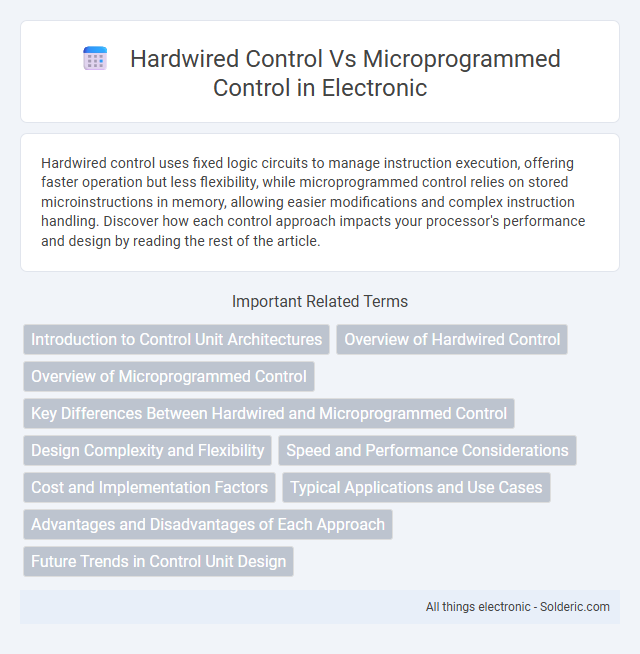Hardwired control uses fixed logic circuits to manage instruction execution, offering faster operation but less flexibility, while microprogrammed control relies on stored microinstructions in memory, allowing easier modifications and complex instruction handling. Discover how each control approach impacts your processor's performance and design by reading the rest of the article.
Comparison Table
| Feature | Hardwired Control | Microprogrammed Control |
|---|---|---|
| Control Implementation | Fixed logic circuits | Microinstructions stored in control memory |
| Flexibility | Less flexible, difficult to modify | Highly flexible, easy to modify |
| Speed | Faster execution | Slower due to microinstruction fetching |
| Complexity | Complex hardware design | Simpler hardware, complex software |
| Cost | Generally higher for complex instructions | Cost-effective for complex instructions |
| Examples | Simple CPUs, early computers | Modern CPUs, RISC processors |
| Control Unit Update | Requires redesign of hardware | Software update of microprogram |
Introduction to Control Unit Architectures
Control unit architectures are primarily classified into hardwired control and microprogrammed control, each defining how instructions are decoded and executed. Hardwired control uses fixed logic circuits to generate control signals, offering faster operation but less flexibility, while microprogrammed control relies on a stored sequence of microinstructions enabling easier modification and complex instruction execution. This distinction is crucial for balancing performance and flexibility in CPU design and implementation.
Overview of Hardwired Control
Hardwired control uses fixed logic circuits to generate control signals, enabling rapid execution of instructions with minimal delay. It relies on combinational and sequential logic components, such as multiplexers and flip-flops, to manage the CPU's operations, offering high-speed performance but limited flexibility. Your system's instruction set and timing are tightly bound to this hardware design, making modifications or upgrades complex.
Overview of Microprogrammed Control
Microprogrammed control uses a set of instructions stored in control memory to generate control signals, offering flexibility in modifying instruction sets and simplifying complex control logic design. It allows easier updates and customization compared to hardwired control, which relies on fixed combinational logic circuits for control signal generation. Your system benefits from microprogrammed control through improved adaptability and maintenance in CPU operation.
Key Differences Between Hardwired and Microprogrammed Control
Hardwired control uses fixed logic circuits to execute instructions, providing faster instruction cycle times but less flexibility in modifying control signals. Microprogrammed control relies on a control memory storing microinstructions, allowing easier updates and complex instruction execution at the cost of slower processing speed. Key differences include speed, flexibility, complexity of implementation, and ease of debugging in CPU architecture design.
Design Complexity and Flexibility
Hardwired control features a simpler design with fixed control signals, resulting in faster execution but limited flexibility for modifications. Microprogrammed control uses a sequence of microinstructions stored in control memory, increasing design complexity but providing greater adaptability for updates and new instruction sets. Your choice between the two depends on whether speed or flexibility is more critical for the specific application.
Speed and Performance Considerations
Hardwired control units typically offer faster instruction execution due to their direct, fixed logic paths optimized for speed, making them suitable for high-performance systems requiring minimal latency. Microprogrammed control units, using stored microinstructions in control memory, provide greater flexibility but incur additional clock cycles per instruction, potentially reducing overall speed. Your choice between these architectures depends on whether priority lies in maximizing raw processing speed with hardwired control or leveraging adaptable instruction sets via microprogramming.
Cost and Implementation Factors
Hardwired control units are generally less expensive to produce for simple, fixed instruction sets due to their direct hardware implementation using combinational logic, resulting in faster operation but limited flexibility. Microprogrammed control units incur higher initial development costs because of their reliance on microcode stored in control memory, which enables easier modifications and support for complex instruction sets without changing the hardware. Implementation complexity in hardwired control increases significantly with instruction set complexity, while microprogrammed control offers scalability and ease of updates, making it more cost-effective for sophisticated processors.
Typical Applications and Use Cases
Hardwired control is typically employed in simple, high-speed processors and embedded systems where rapid instruction execution and minimal control complexity are essential, such as in real-time control units and digital signal processors. Microprogrammed control finds extensive use in complex instruction set computers (CISC), mainframe systems, and processors requiring flexible instruction sets, facilitating easier updates and maintenance through programmable microinstructions. Both control methods are selected based on trade-offs between speed, flexibility, design complexity, and cost in applications ranging from consumer electronics to enterprise computing.
Advantages and Disadvantages of Each Approach
Hardwired control offers faster instruction execution and simpler design, ideal for fixed instruction sets, but lacks flexibility and is challenging to modify or expand. Microprogrammed control provides easier updates and better adaptability to complex instructions through microinstructions, though it generally results in slower performance and increased hardware complexity. Your choice between these approaches depends on prioritizing speed and simplicity versus flexibility and ease of maintenance.
Future Trends in Control Unit Design
Future trends in control unit design emphasize increased integration of adaptive microprogrammed control units leveraging machine learning algorithms to optimize instruction execution dynamically. Advances in hardware description languages and FPGA technologies enable hybrid control units combining hardwired speed with microprogrammed flexibility, enhancing performance in complex computing environments. The shift toward quantum and neuromorphic computing architectures drives research into novel control mechanisms capable of managing non-traditional instruction sets and parallel processing demands.
hardwired control vs microprogrammed control Infographic

 solderic.com
solderic.com